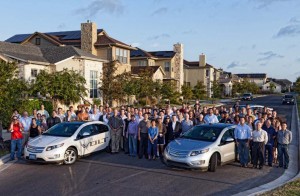“This is one of the few places where you can see a Chevrolet Volt traffic jam,” laughs Scott Hinson, the lab director for Pecan Street Inc., an alternative energy project in Austin, Texas.
More precisely, Pecan Street is part of the one square mile Mueller neighborhood in Austin, Texas that has become the heart of an ambitious project aimed at not only testing out alternative technologies – such as plug-in hybrids like the Chevy Volt plug-in hybrid, as well as “smart grid” electric distribution – but also to run an incredibly detailed analysis of how effective such technologies really are at reducing energy consumption.
The project has drawn the support of not only General Motors but a wide range of utilities and high-tech firms, such as computer maker Dell and chipmaking giant Intel. The U.S. Department of Energy has so far kicked in $10.4 million, private partners another $14 million. But the critical piece of the puzzle has been getting local residents to sign up.
“The project is focused squarely on consumers, enlisting real people to gather data from these homes to help structure next generation energy systems,” Brewster McCracken, the project’s executive director, explained in a statement.
So far, about 600 homes and commercial buildings have agreed to participate. What that means can vary, the most basic requirement being to hook up to a smart grid system and then permit Pecan Street Inc. to closely monitor each home’s consumption of energy at a level akin to the slow-motion cameras networks now use to watch an NFL quarterback’s throw.
As disasters such as Superstorm Sandy, as well as major blackouts that have routinely demonstrated, the nation’s electric grid is creaky, at best, and “It’s not getting better,” John Wellinghoff, the chairman of the Federal Energy Regulatory Commission, told the public interest research group ProPublica. “It’s getting worse.”
Complicating matters, utilities are facing the prospect of having to handle the potential demands of electric vehicles like those Chevy Volts. There are already 60 battery-cars in use in the community covered by the Pecan Street project, most of them Chevrolet plug-ins. Eventually, however, utilities could be asked to power up millions of electric vehicles.
“The electric car represents the largest electric load introduced into a residential home in the last 50, maybe 75 years,” notes Hinson.
Smart grid systems are designed to help maximize both the efficiency and robustness of America’s electric utility network – and make sure there’ll be enough power to go around without necessarily adding 100s of new generating stations. Among other things, Pecan Street participants agree to have power to such things as air conditioning and battery car chargers temporarily interrupted if grid demand peaks.
Meanwhile, the monitoring system takes about 1,440 snapshots every 15 minutes revealing how power is being used in each participating home or business. The data generated is so precise it can reveal when a low-power light bulb is turned on and where – though steps have been taken to maintain participants’ privacy.
Ultimately, the information gathered by the project should help utilities – as well as consumers – understand the literal ebbs and flow of electric demand.
The Pecan Street project also will help get a better understanding of the role utility customers can play in the generation of renewable energy. About 200 participants now have added rooftop solar panels to their homes.
While there’s a nationwide push to increase the use of renewable energy there’s also some pushback from utilities who warn not only of the cost of solar and wind generators but their potentially erratic nature. Several years ago, Texas utilities faced an unexpected brown-out situation when winds becalmed the state’s largest wind farms creating a sudden energy shortage.
General Motors, which has been active in the Pecan Street program, is betting that those Chevy Volts may play a role. The maker is looking at ways to modify the vehicles in subsequent generations so consumers could tap the energy stored in their batteries in the future should a home be hit by a blackout.
An even more expansive program would tap into batteries after the vehicles they’re used in are sent to the scrapyard. The automaker expects that even after a decade of driving there’ll still be plenty of life left in those lithium-ion battery packs.
GM is now partnering with Duke Energy, a major U.S. utility, and ABB, one of the world’s largest suppliers of electric grid equipment, to test the potential of using old electric-vehicle batteries to create an energy backup system. That’s “the Holy Grail,” suggests Duke’s new technology project manager Dan Sowder, because it could “help enable the safe and reliable integration of renewable energy into the grid.”
The partners are testing a prototype battery backup system that could handle four to five homes. Eventually, such devices might be placed throughout the Mueller neighborhood – though even smaller units might be used in individual homes, the partners suggest.
Programs like Pecan Street are helping consumers and utilities alike get a better sense of what the nation’s energy future might look like, one neighborhood at a time.
(This story first appeared on NBCNews.com)

